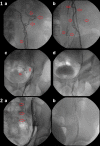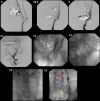Retrograde sclerotherapy of male varicocele with veno-venous shunts - incidence and management: a single-centre experience
- PMID: 36745115
- PMCID: PMC10161912
- DOI: 10.1259/bjr.20221061
Retrograde sclerotherapy of male varicocele with veno-venous shunts - incidence and management: a single-centre experience
Abstract
Objectives: The aim of our study is to compare the incidence of veno-venous shunts in male varicocele and evaluate the possibility to exclude them with manual compression or/and scrotal ligation in order to carry out the procedure of retrograde sclero-embolization.
Methods: In our retrospective study, all patients undergone retrograde sclerotherapy for varicocele in our Interventional Radiology Unit in the last four years were evaluated. Collaterals toward other venous shunts were identified and how many and which patients would be able to complete the procedure safely were considered.
Results: Of the 91 patients, as many as 22 (i.e., 24.17%) patients presented anatomical variants, consisting on shunting into left iliac vein (9 [9.89%]), lumbar left veins (3 [3.29%]), right iliac vein (1 [1.09%]), both iliac veins (1 [1.09%]), left femoral vein (1 [1.09%]) or a more proximal portion of the ISV itself without shunting (3 [3.29%]). Patients with duplication could benefit from a more distal injection in order to prevent back-flow; of the 19 left, nine successfully underwent sclerotherapy with manual compression or/and scrotal ligation, whereas in 10 flow through the collaterals could not be interrupted and patients were demanded for surgery.
Conclusions: Many patients with abnormal communications between the internal spermatic vein and the iliac veins (that is, shunts towards the iliac veins) may as well undergo retrograde sclerotherapy safely if compression/ligation is applied.
Advances in knowledge: No large previous study highlighted the impact of veno-venous shunts in technical feasibility of retrograde sclerotherapy of varicocele.
Conflict of interest statement
Figures



References
-
- Vanlangenhove P, Dhondt E, Everaert K, Defreyne L. Pathophysiology, diagnosis and treatment of varicoceles: a review. Minerva Urol Nefrol 2014; 66: 257–82. - PubMed

